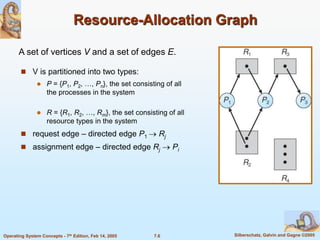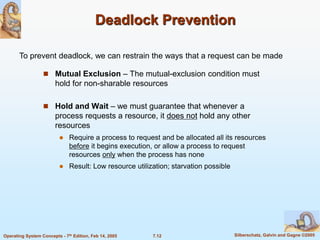Lecture # 10-11 for deadlock operating system.ppt
- 1. Deadlocks
- 2. 7.2 Silberschatz, Galvin and Gagne ©2005 Operating System Concepts - 7th Edition, Feb 14, 2005 The Deadlock Problem A deadlock consists of a set of blocked processes, each holding a resource and waiting to acquire a resource held by another process in the set Example #1 A system has 2 disk drives P1 and P2 each hold one disk drive and each needs the other one Example #2 Semaphores A and B, initialized to 1 P0 P1 wait (A); wait(B) wait (B); wait(A)
- 3. 7.3 Silberschatz, Galvin and Gagne ©2005 Operating System Concepts - 7th Edition, Feb 14, 2005 Bridge Crossing Example Traffic only in one direction The resource is a one-lane bridge If a deadlock occurs, it can be resolved if one car backs up (preempt resources and rollback) Several cars may have to be backed up if a deadlock occurs Starvation is possible
- 4. 7.4 Silberschatz, Galvin and Gagne ©2005 Operating System Concepts - 7th Edition, Feb 14, 2005 System Model Resource types R1, R2, . . ., Rm CPU cycles, memory space, I/O devices Each resource type Ri has 1 or more instances Each process utilizes a resource as follows: request use release
- 5. 7.5 Silberschatz, Galvin and Gagne ©2005 Operating System Concepts - 7th Edition, Feb 14, 2005 Deadlock Characterization Mutual exclusion: only one process at a time can use a resource Hold and wait: a process holding at least one resource is waiting to acquire additional resources held by other processes No preemption: a resource can be released only voluntarily by the process holding it after that process has completed its task Circular wait: there exists a set {P0, P1, …, P0} of waiting processes such that P0 is waiting for a resource that is held by P1, P1 is waiting for a resource that is held by P2, …, Pn–1 is waiting for a resource that is held by Pn, and Pn is waiting for a resource that is held by P0 Deadlock can arise if four conditions hold simultaneously.
- 6. 7.6 Silberschatz, Galvin and Gagne ©2005 Operating System Concepts - 7th Edition, Feb 14, 2005 Resource-Allocation Graph V is partitioned into two types: P = {P1, P2, …, Pn}, the set consisting of all the processes in the system R = {R1, R2, …, Rm}, the set consisting of all resource types in the system request edge – directed edge P1 Rj assignment edge – directed edge Rj Pi A set of vertices V and a set of edges E.
- 7. 7.7 Silberschatz, Galvin and Gagne ©2005 Operating System Concepts - 7th Edition, Feb 14, 2005 Resource-Allocation Graph (Cont.) Process Resource Type with 4 instances Pi requests instance of Rj Pi is holding an instance of Rj Pi Pi Rj Rj
- 8. 7.8 Silberschatz, Galvin and Gagne ©2005 Operating System Concepts - 7th Edition, Feb 14, 2005 Resource Allocation Graph With A Deadlock Before P3 requested an instance of R2 After P3 requested an instance of R2
- 9. 7.9 Silberschatz, Galvin and Gagne ©2005 Operating System Concepts - 7th Edition, Feb 14, 2005 Graph With A Cycle But No Deadlock Process P4 may release its instance of resource type R2. That resource can then be allocated to P3, thereby breaking the cycle.
- 10. 7.10 Silberschatz, Galvin and Gagne ©2005 Operating System Concepts - 7th Edition, Feb 14, 2005 Relationship of cycles to deadlocks If a resource allocation graph contains no cycles no deadlock If a resource allocation graph contains a cycle and if only one instance exists per resource type deadlock If a resource allocation graph contains a cycle and and if several instances exists per resource type possibility of deadlock
- 11. 7.11 Silberschatz, Galvin and Gagne ©2005 Operating System Concepts - 7th Edition, Feb 14, 2005 Methods for Handling Deadlocks Prevention Ensure that the system will never enter a deadlock state Avoidance Ensure that the system will never enter an unsafe state Detection Allow the system to enter a deadlock state and then recover Do Nothing Ignore the problem and let the user or system administrator respond to the problem; used by most operating systems, including Windows and UNIX
- 12. 7.12 Silberschatz, Galvin and Gagne ©2005 Operating System Concepts - 7th Edition, Feb 14, 2005 Deadlock Prevention Mutual Exclusion – The mutual-exclusion condition must hold for non-sharable resources Hold and Wait – we must guarantee that whenever a process requests a resource, it does not hold any other resources Require a process to request and be allocated all its resources before it begins execution, or allow a process to request resources only when the process has none Result: Low resource utilization; starvation possible To prevent deadlock, we can restrain the ways that a request can be made
- 13. 7.13 Silberschatz, Galvin and Gagne ©2005 Operating System Concepts - 7th Edition, Feb 14, 2005 Deadlock Prevention (Cont.) No Preemption – If a process that is holding some resources requests another resource that cannot be immediately allocated to it, then all resources currently being held are released Preempted resources are added to the list of resources for which the process is waiting A process will be restarted only when it can regain its old resources, as well as the new ones that it is requesting Circular Wait – impose a total ordering of all resource types, and require that each process requests resources in an increasing order of enumeration. For example: F(tape drive) = 1 F(disk drive) = 5 F(printer) = 12
- 14. 7.14 Silberschatz, Galvin and Gagne ©2005 Operating System Concepts - 7th Edition, Feb 14, 2005 Deadlock Avoidance Simplest and most useful model requires that each process declare the maximum number of resources of each type that it may need The deadlock-avoidance algorithm dynamically examines the resource-allocation state to ensure that there can never be a circular-wait condition A resource-allocation state is defined by the number of available and allocated resources, and the maximum demands of the processes Requires that the system has some additional a priori information available. a priori: formed or conceived beforehand
- 15. 7.15 Silberschatz, Galvin and Gagne ©2005 Operating System Concepts - 7th Edition, Feb 14, 2005 Safe State That is: If the Pi resource needs are not immediately available, then Pi can wait until all Pj have finished When Pj is finished, Pi can obtain needed resources, execute, return allocated resources, and terminate When Pi terminates, Pi +1 can obtain its needed resources, and so on
- 16. 7.16 Silberschatz, Galvin and Gagne ©2005 Operating System Concepts - 7th Edition, Feb 14, 2005 Deadlock Detection For deadlock detection, the system must provide An algorithm that examines the state of the system to detect whether a deadlock has occurred And an algorithm to recover from the deadlock A detection-and-recovery scheme requires various kinds of overhead Run-time costs of maintaining necessary information and executing the detection algorithm Potential losses inherent in recovering from a deadlock
- 17. 7.17 Silberschatz, Galvin and Gagne ©2005 Operating System Concepts - 7th Edition, Feb 14, 2005 Recovery from Deadlock Two Approaches Process termination Resource preemption
- 18. 7.18 Silberschatz, Galvin and Gagne ©2005 Operating System Concepts - 7th Edition, Feb 14, 2005 Recovery from Deadlock: Process Termination Abort all deadlocked processes This approach will break the deadlock, but at great expense Abort one process at a time until the deadlock cycle is eliminated This approach incurs considerable overhead, since, after each process is aborted, a deadlock-detection algorithm must be re-invoked to determine whether any processes are still deadlocked Many factors may affect which process is chosen for termination What is the priority of the process? How long has the process run so far and how much longer will the process need to run before completing its task? How many and what type of resources has the process used? How many more resources does the process need in order to finish its task? How many processes will need to be terminated? Is the process interactive or batch?
- 19. 7.19 Silberschatz, Galvin and Gagne ©2005 Operating System Concepts - 7th Edition, Feb 14, 2005 Recovery from Deadlock: Resource Preemption With this approach, we successively preempt some resources from processes and give these resources to other processes until the deadlock cycle is broken When preemption is required to deal with deadlocks, then three issues need to be addressed: Selecting a victim – Which resources and which processes are to be preempted? Rollback – If we preempt a resource from a process, what should be done with that process? Starvation – How do we ensure that starvation will not occur? That is, how can we guarantee that resources will not always be preempted from the same process?
- 20. 7.20 Silberschatz, Galvin and Gagne ©2005 Operating System Concepts - 7th Edition, Feb 14, 2005
- 21. 7.21 Silberschatz, Galvin and Gagne ©2005 Operating System Concepts - 7th Edition, Feb 14, 2005 Data Structures used to implement Banker’s Algorithm Available: It is a 1-D array that tells the number of each resource type (instance of resource type) currently available. Example: Available[R1]= A, means that there are A instances of R1 resources are currently available. Max: It is a 2-D array that tells the maximum number of each resource type required by a process for successful execution. Example: Max[P1][R1] = A, specifies that the process P1 needs a maximum of A instances of resource R1 for complete execution. Allocation: It is a 2-D array that tells the number of types of each resource type that has been allocated to the process. Example: Allocation[P1][R1] = A, means that A instances of resource type R1 have been allocated to the process P1. Need: It is a 2-D array that tells the number of remaining instances of each resource type required for execution. Example: Need[P1][R1]= A tells that A instances of R1 resource type are required for the execution of process P1. Need[i][j]= Max[i][j] - Allocation[i][j], where i corresponds any process P(i) and j corresponds to any resouce type R(j)
- 22. 7.22 Silberschatz, Galvin and Gagne ©2005 Operating System Concepts - 7th Edition, Feb 14, 2005 Implementation Types of Bankers Algorithms Resource Request Algorithm Safety Algorithm Resource- Request Algorithm Whenever a process makes a request of the resources then this algorithm checks that if the resource can be allocated or not. Safety Algorithm The safety algorithm is applied to check whether a state is in a safe state or not.




















![7.21 Silberschatz, Galvin and Gagne ©2005
Operating System Concepts - 7th Edition, Feb 14, 2005
Data Structures used to implement
Banker’s Algorithm
Available: It is a 1-D array that tells the number of each resource type
(instance of resource type) currently available. Example:
Available[R1]= A, means that there are A instances of R1 resources
are currently available.
Max: It is a 2-D array that tells the maximum number of each resource
type required by a process for successful execution. Example:
Max[P1][R1] = A, specifies that the process P1 needs a maximum of A
instances of resource R1 for complete execution.
Allocation: It is a 2-D array that tells the number of types of each
resource type that has been allocated to the process. Example:
Allocation[P1][R1] = A, means that A instances of resource type R1
have been allocated to the process P1.
Need: It is a 2-D array that tells the number of remaining instances of
each resource type required for execution. Example: Need[P1][R1]= A
tells that A instances of R1 resource type are required for the execution
of process P1.
Need[i][j]= Max[i][j] - Allocation[i][j], where i corresponds any
process P(i) and j corresponds to any resouce type R(j)](https://image.slidesharecdn.com/lecture10-11-240122142632-b19662a8/85/Lecture-10-11-for-deadlock-operating-system-ppt-21-320.jpg)
